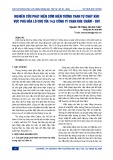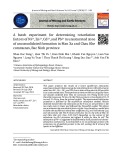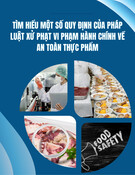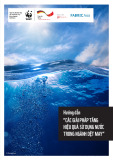219
Special Issue
JOURNAL OF SCIENCE AND TECHNOLOGY DONG NAI TECHNOLOGY UNIVERSITY
SYNTHESIS OF MAGNETIC BIOCHAR MATERIALS FROM CORN COBS
Ho Thi Ngoc Nhung*, Nguyen Truong Thien Y, Le Thi Huynh Nhu, Ly Minh Hien, Nguyen Minh Thong
Dong Nai Technology University *Corresponding author: Ho Thi Ngoc Nhung, hothingocnhung@dntu.edu.vn
GENERAL INFORMATION
ABSTRACT
Received date: 11/04/2024
Revised date: 26/05/2024
Accepted date: 02/08/2024
KEYWORD
Magnetic biochar;
Wastewater treatment;
Corn cob biochar.
increases adsorption capacity
for application
Achieving ecologically sustainable development requires utilizing the added value of waste sources to synthesize functional materials. Currently, Vietnam is a country with developed agriculture, and agricultural by-products are increasing over the years. Making the most of agricultural by- products is a difficult task for local authorities. Agricultural by-products account for a large amount of output such as straw, rice husk, and bagasse. However, the agricultural by- product that accounts for the highest proportion is corn cobs. Due to its physical characteristics, corn cobs are difficult to decompose, leaving a large output for food processing factories. This study describes the process of converting corn cobs by pyrolysis under oxygen limitation into magnetic biochar. The described magnetic biochar can be produced by an improved pyrolysis process at 500°C using iron sulfate as a magnetic precursor and limited oxygen from scavenging gas (gas mixture ratio is 4:1 nitrogen/oxygen). Iron oxide impregnation improves heavy metal ion removal efficiency in and wastewater treatment processes. Results are evaluated through material analysis methods such as SEM, FTIR, BET, XRD, and TGA. This article proposes a feasible waste filtration method to turn corn cobs into valuable materials used as effective heavy metal adsorbent.
1. INTRODUCTION
its for Vietnam is known
is also traditional sustainable agriculture, which is one of the country's economic strengths. Along with the growing agricultural output, the amount of agricultural by-products increasing alarmingly, such as straw, rice husks, bagasse, and corn stalks. Therefore, making the most of these by-products in the biomass production process to create biochar is a part of sustainable development. Biochar, also known as "black gold," is a carbon-rich solid material derived from the thermochemical conversion of biomass (e.g., plants, manure, and sludge) under limited (Manyà et al., 2012). oxygen conditions
JOURNAL OF SCIENCE AND TECHNOLOGY DONG NAI TECHNOLOGY UNIVERSITY
220
Special Issue
to
Common applications of biochar include soil improvement reduce greenhouse gas emissions, reduce soil pollution, improve soil fertility, and treat wastewater (Ghorbani et al., 2020).
evaluate the efficiency of synthesizing magnetic biochar, this study used agricultural by-product corn cobs combined with Fe ions to increase adsorption efficiency in wastewater treatment. Magnetic biochar was pyrolyzed at temperature ranges of 400ºC (BCM-400), 500ºC (BCM-500), and 600ºC (BCM-600)
2. METHODOLOGY
2.1. Chemical
The chemicals for synthesizing magnetic biochar were provided by Xilong Scientific including sulfuric acid and ferric (China), chloride hexahydrate. Corn cobs were collected from Minh Nam Co., Ltd. in Ho Chi Minh City, Vietnam. The experiment was conducted at the laboratory of Dong Nai University of Technology.
2.2. Method
The effectiveness of biochar in removing organic and inorganic pollutants depends on its surface area, pore size distribution, surface functional groups, and the size of the molecules to be removed. However, the physical structure and surface properties of biochar depend on the raw material and the synthesis process. Pyrolysis under limited oxygen is one of the most optimal methods compared to Thermal Conversion, Gasification, or Hydrothermal Carbonization (Zhao et al., 2021). High-temperature pyrolysis usually produces biochar with larger surface areas and pore volumes, making it more suitable for adsorbing organic pollutants, while low- temperature biochar has smaller pores, lower surface areas, and higher oxygen-containing functional groups, making it better for removing inorganic pollutants (Enaime et al., 2020). Thus, in the field of wastewater treatment, biochar shows potential for removing suspended solids and heavy metals due to its low cost and minimal pollution, and it has been highly regarded by many scientists.
The magnetic biochar synthesis process was investigated at different temperature ranges: 400ºC, 500ºC, and 600ºC. Each temperature range used 100 corn cobs, which were collected and washed several times with distilled water. The cobs were then cut into pieces approximately 3-4 cm in length to facilitate handling in the laboratory. The raw materials were soaked in 1M sulfuric acid (H₂SO₄) for 24 hours at room temperature to remove most of the hemicellulose and lignin. The materials were then rinsed several times with distilled water to completely wash away any remaining acid and then dried.
ferric
exchange, Ion
An ideal method for surface modification is the use of chloride hexahydrate (FeCl₃·6H₂O). This solution is non-toxic, can for various improve adsorption capacity strong magnetic pollutants, and provides complexation, properties. electrostatic attraction, and metal–π interactions are mechanisms that make adsorption techniques suitable (Isaac et al., 2022). The biochar was hexahydrate soaked chloride ferric in Despite its promise in heavy metal adsorption from water, biochar use in practice is currently hindered by several challenges. Firstly, biochar has problems with recovery and regeneration, leading to ineffective use (Essandoh et al., 2017). Moreover, its small particle size and low density make it difficult to separate from water (Tan et al., 2016). A promising method to address this issue is combining biochar with magnetic materials (Wang et al., 2020; Yin et al., 2020). For example, metal materials such as iron (Fe), magnesium (Mg), cobalt (Co), nickel (Ni), and zinc (Zn) can be added to biochar's surface (Qin et al., 2017), and magnetic biochar can be prepared using metal salts or metal oxides. To
221
Special Issue
JOURNAL OF SCIENCE AND TECHNOLOGY DONG NAI TECHNOLOGY UNIVERSITY
(FeCl₃·6H₂O) and continuously stirred at 70ºC for 24 hours. Finally, the entire material was filtered and dried before being prepared for pyrolysis at 400ºC, 500ºC, and 600ºC for 1 hour. The obtained biochar was washed with distilled water to remove ash and then dried to a constant in temperature. The product was stored desiccated bags. Before analysis, all samples were ground into fine, homogeneous powder and dried at 105ºC for 24 hours according to standard procedures before transporting the samples for analysis. The biochar samples were analyzed using material analysis methods: SEM, FTIR, EDS, VSM, and BET.
Pyrolysis
Magnetic Biochar
Processed corn cob
Wastewater treatment
Coprecipitatio n
Figure 1. Process for synthesizing magnetic biochar
3. FINDINGS AND DISCUSSION
3.1. Biochar performance and ash content
Before and after pyrolysis, the biochar samples were dried to calculate the biochar yield. Drying also helps save energy and time in the carbonization process (Amalina et al., 2022). Additionally, a large amount of moisture in biomass leads to the production of liquid by- products, such as tar, which significantly affect biochar quality and yield (Al-Rumaihi et al., 2022). The experimental conditions and pyrolysis yields for the BCM samples are shown in Table 1.
Table 1. Magnetic biochar performance and ash content
Weight
Weight after pyrolysis (g)
Yield
Ash
Sample
before
pH
(%)
(%)
1
2
3
Average
pyrolysis (g)
BCM-400
100
35.4
35.6
35.2
35.4
35.4
11.7
7.5
BCM-500
100
32.3
32.5
32
32.2
32.2
16.4
8,9
BCM-600
100
24.5
24.8
24.6
24.6
24.6
25.3
9,8
organic matter increases (Cao et al., 2010). Based on a comparison with Zhao et al. (2018), at a temperature of 500ºC, the author determined the ash content to be 23.27%, which is higher than the result of this study at 16.4%. This comparison The results in Table 1 show that as the pyrolysis temperature increases from 400ºC to 600ºC, the yield decreases from 35.4% to 24.6%, and the ash content increases from 11.7% to 25.3%. As the pyrolysis temperature rises, the mineral and residual combustion content of
JOURNAL OF SCIENCE AND TECHNOLOGY DONG NAI TECHNOLOGY UNIVERSITY
222
Special Issue
shows that the overall assessment has improved the efficiency of the biochar synthesis process.
observed that pyrolysis temperature influences biochar by accelerating the decomposition of acidic substances and promoting the formation of ash from alkaline minerals (Zhao et al., 2018). In addition, biochar produced at lower pyrolysis temperatures may have a higher density of acidic functional groups (Keiluweit et al., 2010).
3.2. Biochar morphology and surface area At the same time, the pH tends to increase from 7.5 to 9.8 as the temperature increases from 400ºC to 600ºC. Based on the report of Mohammad and colleagues (Al-Wabel et al., 2013), increasing the temperature not only raises the ash content from 3.18% to 8.64%, but also increases the pH from 7.37 to 12.38. It has been
Figure 2. Surface morphology results of magnetic biochar. (A) Corn cob before pyrolysis; (B) Model BCM- 400; (C) BCM-500; (D) BCM-600.
to describe evaluated using the BET method, which measures surface area, pore density, and pore volume by introducing nitrogen gas. The results are presented in Table 2.
Table 2. Surface area results (BET)
Pore
Pore
diameter
SBET (m2/g)
(Å)
volume (cm3/g)
BCM-400
58.265
20.273
0.042
The pore distribution is an important factor affecting the adsorption behavior of biochar, as indicated in various studies (Jawad et al., 2020). SEM analysis was used the morphology and surface structure of the BCM- 400, BCM-500, and BCM-600 biochar samples. The structure of the material is a collection of many molecules forming microfibers, which can be arranged longitudinally within the primary cell walls. Between these microfibers are voids, where unbranched cellulose molecules join together to form a solid structure.
BCM-500
149.743
20.641
0.067
BCM-600
97.434
20.765
0.063
confirm the For the BCM-400 sample, the structure remains nearly intact compared to the original corn cob material, indicating that the pyrolysis process was not yet intense. However, as the temperature increases from 500ºC to 600ºC, the amorphous structure of the material breaks down, and numerous cracks appear. The SEM images of these samples observations (Figure 2).
To evaluate the effectiveness of the Fe metal ion addition process to biochar, EDX analysis results show the coexistence of Fe, O and C elements on the surface of ferromagnetic biochar, indicating ferromagnetic iron oxide. This biochar. ability the possibility of to form The surface area of the biochar materials after pyrolysis in an oxygen-limited environment was
223
Special Issue
JOURNAL OF SCIENCE AND TECHNOLOGY DONG NAI TECHNOLOGY UNIVERSITY
3.3. Elemental Analysis demonstrates the successful functionalization of the BCM biochar precursor with iron in solution.
In general, the elemental composition of magnetic biochar changes with pyrolysis temperature, as shown in Table 3. Hydrogen and oxygen content decrease from 5.024% to 1.572% and from 29.643% to 10.378%, respectively, while carbon content increases from 60.541% to 81.227% as the pyrolysis temperature rises from 400°C to 600°C. The reduction in hydrogen and oxygen content in magnetic biochar is due to dehydration of organic compounds and loss of volatile components (Suliman et al., 2016). Furthermore, the H/C and O/C ratios in the magnetic biochar samples decrease significantly from 0.083 to 0.019 and 0.490 to 0.128, respectively. The (O+N)/C ratio in BCM-600 is lower than in BCM-400, likely due to the higher degree of carbonization of organic components and the removal of polar functional groups to form aromatic structures (Uchimiya et al., 2010).
Figure 4. EDX results of biochar. (A) BCM-400; (B) BCM-500; (C) BCM-600.
Table 3. Elemental analysis of the three different biochars
C% H% N% O% O:C H:C N:C (O+N)/C
BCM-400 60.541 5.024 1.469 29.643 0.490 0.083 0.024 0.514
BCM-500 71.434 2.746 2.047 18.842 0.264 0.038 0.029 0.292
BCM-600 81.227 1.572 1.355 10.378 0.128 0.019 0.017 0.144
JOURNAL OF SCIENCE AND TECHNOLOGY DONG NAI TECHNOLOGY UNIVERSITY
224
Special Issue
4. CONCLUSION 3.4. FTIR Analysis
the samples,
The study successfully synthesized magnetic biochar from corn cobs through pyrolysis at various temperatures (400ºC, 500ºC, and 600ºC). The pyrolysis process was enhanced by adding iron ions (Fe) to improve the magnetic properties of the biochar, aiming to increase the adsorption in wastewater efficiency of heavy metals the one treatment. Among pyrolyzed at 500ºC (BCM-500) showed the highest efficiency, with a surface area of 149.743 m²/g, excellent adsorption performance due to its porous structure, and an optimal distribution of surface functional groups.
Additionally, the study indicated that as the pyrolysis temperature increases, the surface area and adsorption capacity of the biochar initially increase but then decrease after reaching a peak at 500ºC. The chemical composition of biochar changes with temperature, with a decrease in hydrogen and oxygen content and an increase in carbon content, which enhances the material's stability and its ability to remove pollutants.
The research results confirm
in wastewater treatment
for
A
FTIR spectroscopy was applied to determine the diversity of functional groups on the surface of the biochar. From the results in Figure 3, the FTIR spectra of the three types of biochar are shown. The peak intensity of CO₃²⁻ (1430 cm⁻¹) and PO₄³⁻ (1083 cm⁻¹) increased as the temperature rose, due to the decomposition of water and organic matter into minerals containing PO₄³⁻ and CO₃²⁻ at high temperatures (Cao et al., 2019). The peaks at 3385 and 2910 cm⁻¹ represent the presence of phenolic- OH and methyl C-H (Sun et al., 2022), with their intensity increasing initially and then decreasing as the temperature continued to rise, peaking at 500°C. Conversely, the peak intensity at 1600 cm⁻¹, representing the carbonyl/carboxyl C=O aromatic group (Al-Wabel et al., 2013), increased as the pyrolysis temperature reached 500°C and then remained stable from 500°C to 600°C. As the pyrolysis temperature increased, the intensities of the peaks at 874 and 796 cm⁻¹ (aromatic C-H vibrations) also increased (Bhuyar et al., 2019), indicating that the aromaticity of the biochar also increased, which is consistent with the results presented in Table 3. The surface functional groups of biochar did not differ significantly at the three pyrolysis temperatures, but the biochar pyrolyzed the highest (BCM-500) showed at 500°C oxygen-containing intensity absorption functional groups. the high potential of magnetic biochar derived from corn cobs technologies, particularly for the removal of heavy metals. This provides a sustainable and efficient solution, while also helping to utilize agricultural by- products and reduce environmental pollution.
B
C
ACKNOWLEDGEMENT
We appreciate the analysis results of the Institute of Science and Technology for supporting us. At the same time, thank Dong Nai University of Technology for supporting us with laboratory equipment to conduct this experiment smoothly.
REFERENCES
Figure 3. FTIR spectrum of magnetic biochar. (A) BCM-400; (B) BCM-500; BCM-600.
Al-Rumaihi, A., Shahbaz, M., Mckay, G., Mackey, H., & Al-Ansari, T. (2022). A
225
Special Issue
JOURNAL OF SCIENCE AND TECHNOLOGY DONG NAI TECHNOLOGY UNIVERSITY
use potential in
its remediation. Bioresource technology, 101(14), 5222- 5228.
review of pyrolysis technologies and feedstock: A blending approach for plastic and biomass towards optimum biochar yield. Renewable and Sustainable Energy Reviews, 167, 112715.
potential use in
Cao, X., & Harris, W. (2010). Properties of dairy-manure-derived biochar pertinent to its remediation. Bioresource technology, 101(14), 5222- 5228.
(2020). Biochar
Al-Wabel, M. I., Al-Omran, A., El-Naggar, A. H., Nadeem, M., & Usman, A. R. (2013). Pyrolysis temperature induced changes in characteristics and chemical composition of biochar produced from conocarpus wastes. Bioresource technology, 131, 374- 379.
Enaime, G., Baçaoui, A., Yaacoubi, A., & Lübken, M. for treatment—conversion wastewater technologies and applications. Applied Sciences, 10(10), 3492.
Al-Wabel, M. I., Al-Omran, A., El-Naggar, A. H., Nadeem, M., & Usman, A. R. (2013). Pyrolysis temperature induced changes in characteristics and chemical composition of biochar produced from conocarpus wastes. Bioresource technology, 131, 374- 379.
Essandoh, M., Wolgemuth, D., Pittman, C. U., Mohan, D., & Mlsna, T. (2017). Adsorption of metribuzin from aqueous solution using magnetic and nonmagnetic sustainable low-cost biochar adsorbents. Environmental Science and Pollution Research, 24, 4577-4590.
lignocellulosic findings on
Amalina, F., Abd Razak, A. S., Krishnan, S., Sulaiman, H., Zularisam, A. W., & (2022). Advanced Nasrullah, M. techniques in the production of biochar from and biomass applications. Cleaner environmental Materials, 6, 100137.
Ghorbani, M., Konvalina, P., Neugschwandtner, R. W., Kopecký, M., Amirahmadi, E., Moudrý Jr, J., & Menšík, L. (2022). Preliminary cadmium bioaccumulation and photosynthesis in rice (Oryza sativa L.) and maize (Zea mays L.) using biochar made from C3-and C4- originated straw. Plants, 11(11), 1424.
Bhuyar, P., Hong, D. D., Mandia, E., Rahim, M. H. A., Maniam, G. P., & Govindan, N. (2019). Desalination of polymer and chemical industrial wastewater by using green photosynthetic microalgae, Chlorella sp. Maejo International Journal of Energy and Environmental Communication, 1(3), 9-19. Isaac, R., & Siddiqui, S. (2022). Sequestration of Ni (II) and Cu (II) using FeSO4 modified Zea mays husk magnetic biochar: Isotherm, kinetics, thermodynamic studies and RSM. Journal of Hazardous Materials Advances, 8, 100162.
Cao, X., & Harris, W. (2010). Properties of dairy-manure-derived biochar pertinent to Jawad, A. H., Hum, N. N. M. F., Farhan, A. M., & Mastuli, M. S. (2020). Biosorption of
JOURNAL OF SCIENCE AND TECHNOLOGY DONG NAI TECHNOLOGY UNIVERSITY
226
Special Issue
decontamination of wastewater: a review. Bioresource technology, 212, 318-333.
methylene blue dye by rice (Oryza sativa L.) straw: adsorption and mechanism study. Desalin Water Treat, 190, 322-330.
Uchimiya, M., Wartelle, L. H., Lima, I. M., & (2010). Sorption of Klasson, K. T. litter deisopropylatrazine on broiler biochars. Journal of agricultural and food chemistry, 58(23), 12350-12356.
Keiluweit, M., Nico, P. S., Johnson, M. G., & Kleber, M. (2010). Dynamic molecular structure of plant biomass-derived black carbon (biochar). Environmental science & technology, 44(4), 1247-1253.
Manyà, J. J. (2012). Pyrolysis for biochar purposes: a review to establish current knowledge gaps and research needs. Environmental science & technology, 46(15), 7939-7954. Wang, H., Zhao, W., Chen, Y., & Li, Y. (2020). Nickel aluminum layered double oxides modified magnetic biochar from waste corncob for efficient removal of acridine orange. Bioresource Technology, 315, 123834.
Qin, Y., Wang, H., Li, X., Cheng, J. J., & Wu, W. (2017). Improving methane yield from organic fraction of municipal solid waste rice-straw (OFMSW) with magnetic biochar. Bioresource technology, 245, 1058-1066. Yin, Z., Xu, S., Liu, S., Xu, S., Li, J., & Zhang, Y. (2020). A novel magnetic biochar prepared by K2FeO4-promoted oxidative pyrolysis of pomelo peel for adsorption of hexavalent Bioresource chromium. technology, 300, 122680.
Suliman, W., Harsh, J. B., Abu-Lail, N. I., Fortuna, A. M., Dallmeyer, I., & Garcia- Perez, M. (2016). Influence of feedstock source and pyrolysis temperature on biochar bulk and surface properties. Biomass and Bioenergy, 84, 37-48. Zhao, B., O'Connor, D., Zhang, J., Peng, T., Shen, Z., Tsang, D. C., & Hou, D. (2018). Effect of pyrolysis temperature, heating rate, and residence time on rapeseed stem derived biochar. Journal of Cleaner Production, 174, 977-987.
quantitative investigation
Zhao, Q., Xu, T., Song, X., Nie, S., Choi, S. E., (2021). Preparation and & Si, C. application in water treatment of magnetic biochar. Frontiers in Bioengineering and Biotechnology, 9, 769667.
Sun, D., Li, F., Jin, J., Khan, S., Eltohamy, K. M., He, M., & Liang, X. (2022). Qualitative and on adsorption mechanisms of Cd (II) on from co- modified biochar derived pyrolysis of straw and sodium phytate. Science of the Total Environment, 829, 154599.
Tan, X. F., Liu, Y. G., Gu, Y. L., Xu, Y., Zeng, G. M., Hu, X. J., ... & Li, J. (2016). Biochar-based nano-composites for the













![Bài giảng Chế biến khoáng sản vô cơ [Mới nhất]](https://cdn.tailieu.vn/images/document/thumbnail/2025/20251025/thanhvan173002/135x160/21521761538638.jpg)








